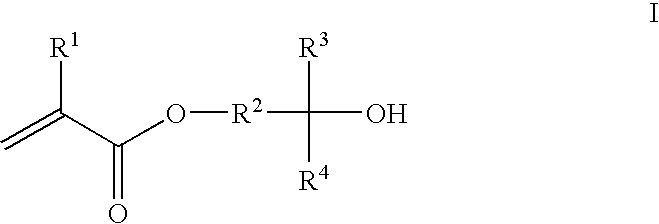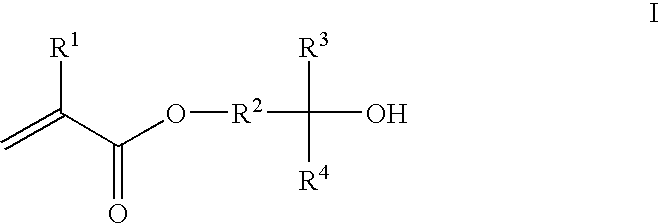Photoresist composition
a composition and photoresist technology, applied in the field of photoresist composition, can solve the problems of difficult incorporation of new photoresist properties, material swelling, and unsuitability of 248 nm imaging phenolic polymers, and achieve the effects of high quality, control of molecular weight and polydispersity, and easy copolymerization
- Summary
- Abstract
- Description
- Claims
- Application Information
AI Technical Summary
Benefits of technology
Problems solved by technology
Method used
Image
Examples
example 1
Synthesis of 1,1,1-trifluoro-2-trifluoromethyl-2-hydroxy-5-pentyl methacrylate and 1,1,1-trifluoro-2-trifluoromethyl-2-hydroxy-4-pentyl methacrylate (II and III)
Preparation of 1,1,1-trifluoro-2-trifluoromethyl-2,5-pentanediol and 1,1,1-trifluoro-2-trifluoromethyl-Z 4-pentanediol:
To a 3-necked, 3-L round bottomed flask equipped with an overhead stirrer, digital thermometer and a 1-L constant-pressure addition funnel with a nitrogen inlet was added 974 mL (1.95 mol) of borane-dimethylsulfide complex (2.0M in THF). The addition funnel was charged with a solution of 353 g (1.7 mol) of 1,1,1-trifluoro-2-trifluoromethyl-4-penten-2-ol in 400 mL of anhydrous THF. The flask was cooled and the olefin was added slowly with stirring while maintaining a temperature below 15° C. The mixture was stirred at room temperature for two days after which time it was recooled and 750 mL (2.25 mol) of 3M NaOH(aq) was added carefully. The reaction mixture was reduced in volume on a rotary evaporator and...
example 2
Synthesis of 2-{[5-(1′,1′,1′-trifluoro-2′-trifluoromethyl-2′-hydroxy)propyl]norbornyl}methacrylate (IV)
Preparation of 2-hydroxy-5-[(1′,1′,1′-trifluoro-2′-trifluoromethyl-2′-hydroxy)propyl]norbornane:
To a 3-necked, 500-mL round bottomed flask equipped with a condenser (nitrogen inlet), digital thermometer and magnetic stir bar was added 173.2 g (0.63 mol) of 5-[(1′,1′,1′-trifluoro-2′-trifluoromethyl-2′-hydroxy)propyl]-2-norbornene and 100 g (1.9 mol) of formic acid (88%) and the mixture heated at 100° C. under nitrogen overnight. The resulting yellow solution was evaporated on a rotary evaporator leaving a thick yellow oil to which was added 120 mL of concentrated ammonium hydroxide (28%) and the mixture heated with stirring at 60° C. overnight. After cooling, the layers were separated and the lower layer was diluted with 500 mL of diethylether and washed sequentially with 5% (v / v) HCl (2×250 mL), water (2×200 mL) and brine. The ether solution was dried over MgSO4, evaporated and...
example 3
Synthesis of 6-methacryloxymethyl-2-naphthol (XII)
Preparation of methyl 6-hydroxy-2-naphthoate:
To a 1-L round bottomed flash equipped with a nitrogen inlet and magnetic stir bar was added 50 g (0.27 mol) of 6-hydroxy-2-naphthoic acid and 400 mL of methanol. The suspension was treated slowly with 1 mL of con. H2SO4 and stirred at room temperature overnight. The resulting solution was evaporated, taken up in 500 mL of ethyl acetate and washed sequentially with 3×300 mL of saturated NaHCO3, 2×300 in L of water and brine. The pale yellow solution was dried over MgSO4, reduced in volume to about 100 mL and slowly treated with hexane. The resulting crystalline precipitate was collected and dried under a stream of nitrogen to yield 52 g (95%) of the title compound as fine, white plates, mp 196° C.
Preparation of 6-hydroxymethyl-2-naphthol:
To a 3-necked, 1-L round bottomed flask equipped with an overhead stirrer, digital thermometer and 500-mL constant-pressure addition funnel with a...
PUM
| Property | Measurement | Unit |
|---|---|---|
| wavelengths | aaaaa | aaaaa |
| wavelengths | aaaaa | aaaaa |
| wavelengths | aaaaa | aaaaa |
Abstract
Description
Claims
Application Information
 Login to View More
Login to View More - R&D
- Intellectual Property
- Life Sciences
- Materials
- Tech Scout
- Unparalleled Data Quality
- Higher Quality Content
- 60% Fewer Hallucinations
Browse by: Latest US Patents, China's latest patents, Technical Efficacy Thesaurus, Application Domain, Technology Topic, Popular Technical Reports.
© 2025 PatSnap. All rights reserved.Legal|Privacy policy|Modern Slavery Act Transparency Statement|Sitemap|About US| Contact US: help@patsnap.com



